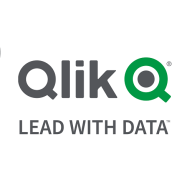

Qlik Sense and Oracle Analytics Cloud compete in the business intelligence and data analysis category. Qlik Sense has an edge in user-friendly data visualization, while Oracle Analytics Cloud excels in integrating with Oracle products for comprehensive analytics.
Features: Qlik Sense is known for its associative model that enables dynamic data exploration. It allows users to manipulate data with drag-and-drop functionality and efficiently manages large datasets. Oracle Analytics Cloud shines with its deep integration into Oracle's ecosystem, offering advanced analytics and ease of use for Oracle environments. It provides robust predictive analytics and integration capabilities that cater to enterprise solutions.
Room for Improvement: Qlik Sense users suggest improvements in statistical functions, customization options for visualizations, and better integration tools. Users desire more features from QlikView. Oracle Analytics Cloud feedback includes the need for enhanced user interaction, cost-effectiveness, and further development in machine learning capabilities.
Ease of Deployment and Customer Service: Qlik Sense provides versatile deployment options, supporting on-premises and private cloud setups, backed by a strong community, though some users mention technical support responsiveness could improve. Oracle Analytics Cloud is noted for its excellent global support and hybrid deployment, with users praising its customer service and superior technical assistance.
Pricing and ROI: Qlik Sense is perceived as expensive, with complex licensing, but delivers substantial ROI through quick deployment and insights. Oracle Analytics Cloud offers competitive pricing, although costs can rise with increased usage, yet ROI is favorable due to its rich enterprise features aligning with business needs.


Oracle Analytics is a complete platform with ready-to-use services for a wide variety of workloads and data.
Oracle Analytics allows businesses to add AI and machine learning capabilities to any application—and as part of our integrated suite of cloud services to comply with data security and connected without disrupting business operations.
Offering valuable, actionable insights from all types of data—in the cloud, on-premises, or in a hybrid deployment—Oracle Analytics empowers business users, data engineers, and data scientists to access and process relevant data, evaluate predictions, and make quick, accurate decisions.
Oracle Analytics Cloud Features
Oracle Analytics Cloud has many valuable key features. Some of the most useful ones include:
Oracle Analytics Cloud Benefits
There are many benefits to implementing Oracle Analytics Cloud. Some of the biggest advantages the solution offers include:
Reviews from Real Users
Below are some reviews and helpful feedback written by PeerSpot users currently using the Oracle Analytics Cloud solution.
Fabricio Q., Data Analytics Manager, says, “The main functionality is great and everything is pretty standard and easy to use. It's great for consolidation and creating one source of truth. The initial setup is pretty straightforward.”
PeerSpot user, Eric B., Independent Consultant - Oracle BI Applications at Desjardins, mentions “It's really an enterprise solution. It has standard dashboarding functionality. It also has reporting capabilities for producing pixel-perfect reports, bursting large volumes of a document if you need to. It has interactive data discovery functionality, which you would use to explore your data, bring your own data, and merge it with maybe the data from an enterprise data warehouse to get new insights from the pre-existing data. It has machine learning embedded in the solution.”
Gaurav S., Vice President Credit Risk Management at a financial services firm, explains, “From a financial or bank perspective, this product is secure enough. The dashboards, analytics, visualizations, and different reports are valuable for business analytics. The AI/ML enablement is useful, as many reporting tools do not offer machine learning models as of now, without writing customized code.”
Another reviewer, Trinh P., Delivery Manager at Sift Ag, comments, "The specific capability I find important in Oracle Analytics Cloud is that it allows the basic user to easily drag and drop data. I also like that the solution allows the user to decide what to measure and what to see in the reports."
Qlik Sense is a visual analytics and business intelligence (BI) platform that gives users full control over their system’s data. From this platform they can control every aspect of their system data. It maximizes an organization’s ability to make decisions driven by their data.
Benefits of Qlik Sense
Some of the benefits of using Qlik Sense include:
Reviews from Real Users
Qlik Sense stands out among its competitors for a number of reasons. Two major ones are its associative analytics technology and its remote access capability. Qlik Sense employs an associative analytics engine that gives users the ability to take their data analytics to the next level. Users can create visual connections between different datasets spread across their network, creating deep insights that enable users to gain a full understanding of their data. This engine is easily scaled up to allow a large number of users to benefit from the deep insights that it provides. Users can access Qlik Sense from anywhere in the world. Qlik Sense has an online portal that can be used consistently from anywhere at all. Having the ability to remotely analyze data gives users flexibility when it comes to choosing how to deploy their manpower.
Jarno L., the managing director of B2IT, writes, “The associative technology features are the solution's most valuable aspects. Qlik was the first company to implement an in-memory associative analytics engine. This basically means that all data is loaded into memory, but it also means that instead of joining data together, the data is associated together. From the front end, from the user interface point of view, data can be joined or included or excluded on the fly. It can be drilled down and drilled through and users can slice and dice it and that type of thing can be done from anywhere in the data to any other place in the data. It doesn't have to be predefined. It doesn't have to have hierarchies or anything like that.”
Tami S., the senior business intelligence analyst at the La Jolla Group, writes, “With the changing business landscape, it is nice to access Qlik Sense through an external website. As an organization when we use QlikView Desktop, we need to connect to our internal network. We can access QlikView through the QlikView access point but the website has a little different look and feel than the desktop application. We appreciate that Qlik Sense is browser-based and the user experience is the same whether at home, in the office or on a boat. As long as the user has internet access, performance is the same.”
We monitor all Data Visualization reviews to prevent fraudulent reviews and keep review quality high. We do not post reviews by company employees or direct competitors. We validate each review for authenticity via cross-reference with LinkedIn, and personal follow-up with the reviewer when necessary.